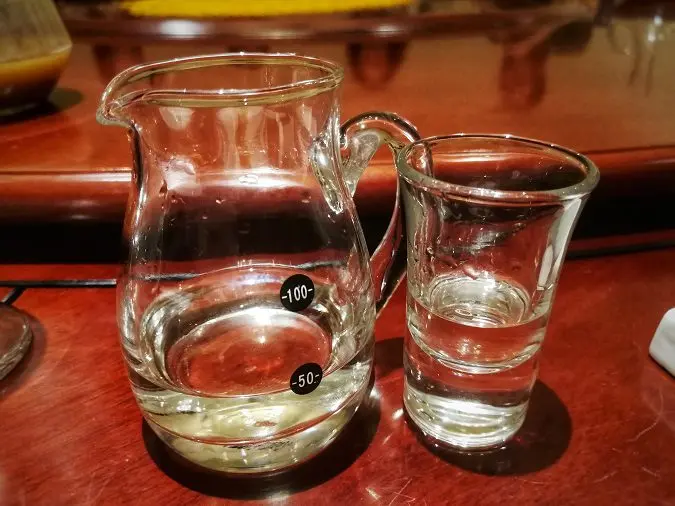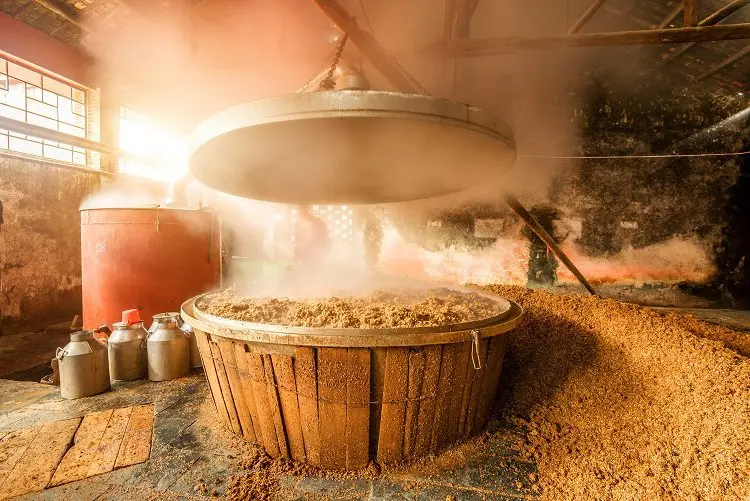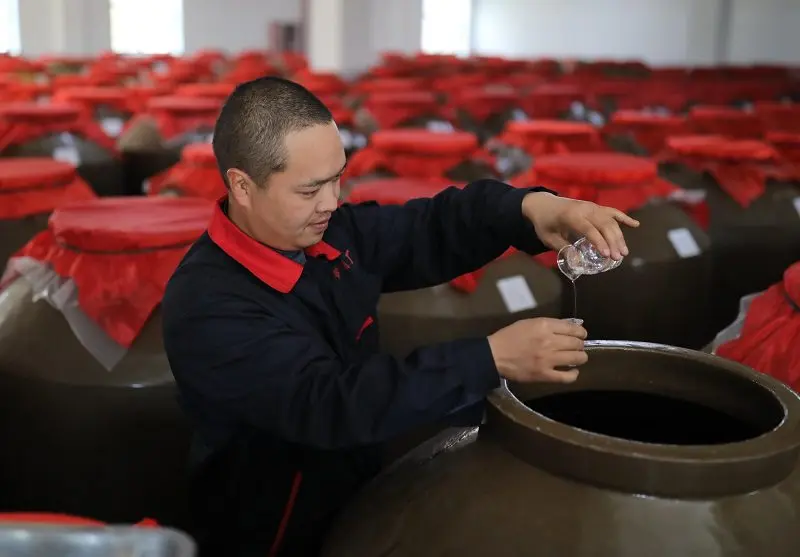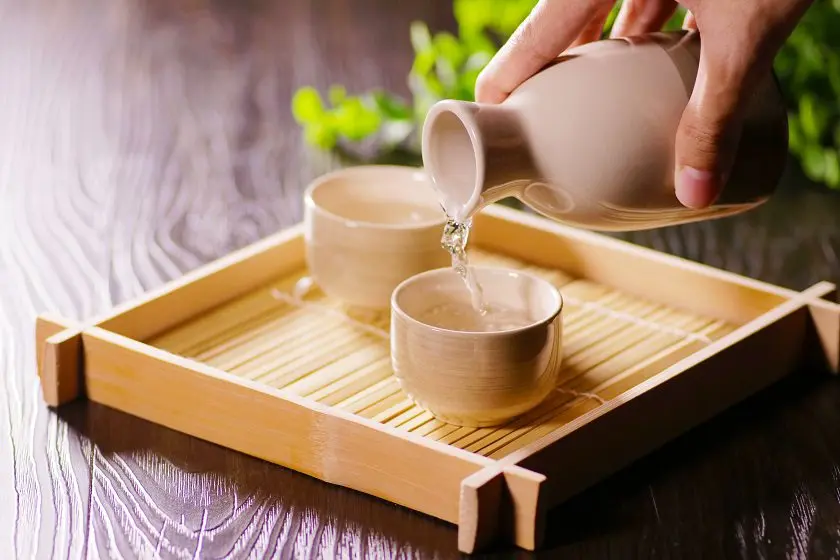Baijiu is a strong (average 55%) Chinese distillate. The drink is made from grain, and its name translates as “white (transparent) alcohol.” Traditionally, sorghum is used as a raw material, but other options are also possible: glutinous rice (in the south of the country), wheat, barley, millet, and even Job’s tears plant (in the north). Baijiu is often compared to other Asian distillates, such as Japanese shochu or Korean soju, but it is much stronger and closer to Russian vodka.
Although it is still exotic for us, baijiu is the most popular alcoholic drink in the world, its sales reach 5 billion liters per year.

Production technology
The whole process consists of five main cooking steps:
- Preparation of raw materials. The grain or beans are washed, sometimes crushed or steamed, but may be left whole and raw.
- Blank “chu” – Qu. The ground grains are diluted with water, pressed into dense briquettes and left in a warm, humid place for several weeks. After about a month, mold and yeast appear in the “chu”, which is necessary for the next stage.
- Saccharification. In the Western tradition, the grain is first germinated, turning into malt, the enzymes of which break down starch into sugar. Instead of malt, Chinese distillers use powdered “chu”, previously dissolved in water. Starch is broken down into sugar not by enzymes from malt, but by mold fungi.
- Fermentation (fermentation). Yeast from “Chu” converts sugar into alcohol and carbon dioxide. In some cases, fermentation takes place in giant ceramic jugs, in others, holes dug in the ground are used.
- Distillation. The number of distillations depends on the type of drink and the manufacturer. Modern producers have the right to add additional ingredients to alcohol, apply filtration, and use other techniques to improve the taste.

Baijiu types
There are many subspecies of baijiu, depending on the variety, not only the quality and taste profile, but also the price changes. The main criterion for classification is the aroma, which can be:
- “Saucy”: with obvious tones of soy sauce and pasta. A solvent is felt in the bouquet, the taste is sharp. This type of baijiu goes well with canned or pickled foods, the most famous representative of the style is the Maotai type. Baiju sauce is sometimes even called “mao”.
- Strong. It has a sweetish taste, oily structure, persistent long-lasting aroma. Often made with Aspergillus molds. Representatives: Wuliangye, Liuilingzui.
- Weak. Delicate, dry, full-bodied. Representative: Fenjiu.
- Rice. This category includes baijiu made from rice, such as Sanhuajiu.
- “Phoenix”. The drink is fermented in pits and aged in rattan containers. The taste is rich, fruity, with earthy notes. Representative: Xifengjiu.
- Mixed. A blend of several types of baijiu. The characteristics of drinks in this category vary greatly depending on the manufacturer.

In addition, baijiu can be flavored and not. The first category includes the following subtypes:
- Mei Kuei Lu Chiew (“pink essence”). Distilled with roses and sugar.
- Moutai (aka Maotai). The type appeared in the city of the same name about 200 years ago, the manufacturing technology includes 7 fermentation cycles in the seed, wheat and sorghum serve as raw materials.
- Guotai. Passes 7 distillations, is made from wheat and red sorghum.
- Osmanthus wine – has a strength of only 17-18%, the finished product is flavored with the flowers of fragrant Osmanthus.
- Wu Chia Pi Chiew. With Chinese medicinal herbs.
- Yuk Bing Siu Zau. Vodka made from steamed rice. After distillation, pork fat is added to the drink, but it is removed before bottling. The fortress reaches 30%.
- Sanhuajiu. A rice distillate with over a thousand years of history. It is made on the basis of spring water, flavored with meadow flowers.
- Chu Yeh Ching. It is made with Chinese medicinal herbs, including bamboo leaves, thanks to which it acquires a yellow-green color. Fortress up to 46%.
- To Mei Chiew. It is made from rice wine with the addition of flowers and sugar syrup. Aged for at least a year, the fortress does not exceed 30%.
- Pi Lu Chiew. Chinese medicinal herbs are soaked in the finished distillate, sugar is added.
- Imperial Lotus White Chiew. The composition includes 20 medicinal plants.
- Chajiu. Flavored with tea leaves and hawthorn berries. The fortress varies from 8% to 28%.
- xifengjiu. It is made on the basis of barley with the addition of peas.
Unflavored baiju is divided into the following subspecies:
- Yanghe. Appeared during the Sui and Tang dynasties. It is made from excellent sorghum, wheat, barley and peas.
- fenjiu. Appeared around 550 AD, the raw material is sorghum, the fortress reaches 65%.
- Erguotou. Sorghum baijiu of the second distillation is especially popular in Beijing among representatives of working specialties. A well-known brand is Red Star.
- Luzhou Laojiao. Known for the rich aroma of fermented peaches, acquired as a result of fermentation in vessels made of special clay.
- Liulingzui jiu. More than 2000 years old, excellent quality, made in strict accordance with traditional methods.
- Kaoliang wine. Sorghum distillate from the city of Tianjin with a strength of 45-63%.
- Daqujiu. It is made from sorghum and wheat, a distinctive feature is long-term fermentation.
- Shuangzhengjiu. Double distilled rice distillate, 32% ABV.
- Sanzhengjiu. Rice distillate of triple distillation with a strength of 38-39%.
- Wuliangye. Aged baijiu based on five grains: sorghum, rice, glutinous rice, corn, wheat.
- Jiugui (“drunk ghost”). Made from spring water, sorghum, glutinous rice and wheat, the strength varies from 38% to 54%.
- Gujinggongjiu (“traditional drink from the well”). Produced from well water.
How to drink baijiu
Chinese baijiu vodka (more correctly called moonshine) is served slightly warmed up in special ceramic cups. Often, the drink is sold in a set with everything necessary for proper serving. The fact is that earlier, due to the imperfection of the distillation technology, baijiu contained a lot of essential oils, and an increase in temperature made it possible to partially improve the taste of alcohol. Although now there is no need for heating, the tradition has remained.

True, it is gradually becoming fashionable to drink baijiu at room temperature and even slightly chilled.
Strong alcohol in China is customary to have a plentiful snack with hearty hot food, mostly national. Specific dishes depend on the type of vodka: baijiu with a strong flavor goes well with spicy Sichuan dishes, the “saucy” version is served with spicy foods in Guizhou.
As for gastronomic combinations with European dishes, connoisseurs recommend grilled meat, smoked wings, fatty sausages. With lighter variations of the drink, you can serve seafood, citrus salads, white chicken meat.









